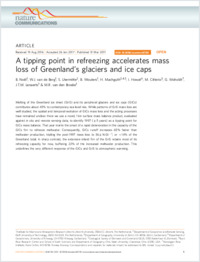A tipping point in refreezing accelerates mass loss of Greenland’s glaciers and ice caps
- Noël, B. Institute forMarine and Atmospheric Research Utrecht, Utrecht University, The Netherlands
- Berg, W. J van de Institute forMarine and Atmospheric Research Utrecht, Utrecht University, The Netherlands
- Lhermitte, S. Department of Geoscience and Remote Sensing,Delft University of Technology, Delft, The Netherlands
- Wouters, B. Institute forMarine and Atmospheric Research Utrecht, Utrecht University, The Netherlands
- Machguth, Horst Department of Geography, University of Zuerich, Switzerland - Department of Geosciences, University of Fribourg, Switzerland - Geological Survey of Denmark and Greenland GEUS, Denmark
- Howat, I. Byrd Polar Research Center and School of Earth Sciences and Department of Geography, Ohio State University, Columbus, Ohio, USA
- Citterio, M. Geological Survey of Denmark and Greenland GEUS, Denmark
- Moholdt, G. Norwegian Polar Institute, Fram Centre, NO-9296 Tromsø, Norway
- Lenaerts, J. T. M. Institute forMarine and Atmospheric Research Utrecht, Utrecht University, The Netherlands
- Broeke, M. R. van den Institute forMarine and Atmospheric Research Utrecht, Utrecht University, The Netherlands
-
31.03.2017
Published in:
- Nature Communications. - 2017, vol. 8, p. 14730
English
Melting of the Greenland ice sheet (GrIS) and its peripheral glaciers and ice caps (GICs) contributes about 43% to contemporary sea level rise. While patterns of GrIS mass loss are well studied, the spatial and temporal evolution of GICs mass loss and the acting processes have remained unclear. Here we use a novel, 1 km surface mass balance product, evaluated against in situ and remote sensing data, to identify 1997 (±5 years) as a tipping point for GICs mass balance. That year marks the onset of a rapid deterioration in the capacity of the GICs firn to refreeze meltwater. Consequently, GICs runoff increases 65% faster than meltwater production, tripling the post-1997 mass loss to 36±16 Gt−1, or ∼14% of the Greenland total. In sharp contrast, the extensive inland firn of the GrIS retains most of its refreezing capacity for now, buffering 22% of the increased meltwater production. This underlines the very different response of the GICs and GrIS to atmospheric warming.
- Faculty
- Faculté des sciences et de médecine
- Department
- Département de Géosciences
- Language
-
- English
- Classification
- Meteorology, climatology
- License
-
License undefined
- Identifiers
-
- RERO DOC 288661
- DOI 10.1038/ncomms14730
- Persistent URL
- https://folia.unifr.ch/unifr/documents/305585
Statistics
Document views: 114
File downloads:
- pdf: 146
